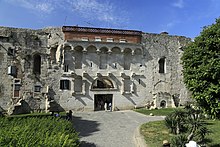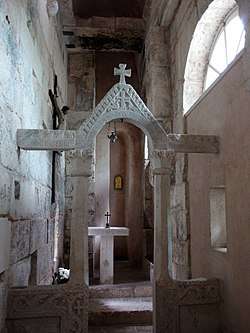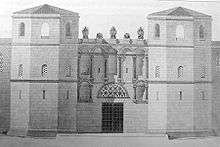Golden Gate (Diocletian's Palace)
The Golden Gate (Croatian: Zlatna vrata), Latin: Porta Aurea), or "the northern gate" is one of the four principal Roman gates into the stari grad (old town) of Split that was once Diocletian's Palace. Originally the main gate from which the Emperor entered the complex, the gate is on the road to the north, towards Salona, the then capital of the Roman province of Dalmatia and Diocletian's birthplace.
| Golden Gate | |
|---|---|
| Native name Croatian: Zlatna vrata | |
 The Golden Gate (Porta Aurea) May 2018 | |
| Type | Gatehouse |
| Location | Split, Croatia |
| Coordinates | 43°30′33″N 16°26′26″E |
| Built | 4th century AD |
| Built by | Diocletian |
| Architectural style(s) | Roman |
 Location of Golden Gate in Croatia | |
History
During the late antiquity, the gate was known as the Porta septemtrionalis ("the northern gate") and Diocletian (†316) probably entered his palace through this gate after his abdication from the imperial throne on 1 May 305.[1] In the Middle Ages, the gate was known by the name "Roman Gate" (Porta Romae).[2]
In the 6th century, above the outer part of the gate a small church dedicated to St Martin. This coincided with the complex seeing an influx of refugees from outlining communities. Built into a narrow corridor (1.64 x 10 meters)[3] that had once been used as a guardhouse at the time of Diocletian (285–305), with the windows (now filled in) on the south side for surveillance on approach to the main gate into the complex, simmer churches were over the Silver Gate, the Iron Gate, and the Bronze Gate. Above the church of St Martin, a pre-Romanesque bell tower was erected (later demolished in the 19th century). It was similar in style to the church bell tower of Our Lady of Zvonik above the Iron Gate, which still exists.
During the early Middle Ages, the gates were besieged so that a smaller passage to the north side of the city was eastern to the east, and the expansion of the medieval town to the west was opened by the Door of Picture, located west of the northwestern tower of the palace, which has since been the main entrance to the city on the north side. During the Renaissance, the gate was given its present name, and this name was first mentioned in 1553 in the itinerary of the Venetian trade unions Died and Giustiniana.[4]
In around 1630, the Venetian governor Alvise Zorzi gave the foundations of eleven Roman towers on the north and east side of the Diocletian's palace wall, among them octagonal towers that once defended the Golden Gate. The stone material from the ruined towers was transported to Venice on boats, to be used in the construction of Santa Maria della Salute.[5] The Golden Gate was only re-opened in 1857,[6] after the demolished houses that had built up against the north wall of the palace and the ground in front of the cleansed centuries-old earth embankments. Despite the cleansing, today around 2 meters the door and wall of the palace are below the ground level. The most recent reconstruction was carried out in the first years of the new millennium by metropolis, with the gate covered in a Building wrap from 2012 until 2015. Today (2020) the building is open to the public.
Description
The Porta septemtrionalis was the main gate of Diocletian's palace, located in the middle of the northern wall. It sits on Cardo maximus within the palace and runs to the Porta Aenea. Today they are 4.50 m high and their original height was about 6.50 m, since at present the northern wall with the door is still partially covered with earthenware that accumulated for centuries.[7] The lower opening is 4.17 x 4.36 meters, over it there is a lintel (architrave) of nine romoid stone blocks of height 0.91 m, and above it is decorated a rasteret arch of 19 stone blocks with a height of 3.02 m.[8]

On the left and right side of the gate are two niches and one central over the arches where the statues of the Tetrarch's, Diocletian, Maximian, Galerius and Constantius Chlorus.[9] Above are seven blind arcades that stand on capitals missing columns lying on menzolama. Above the arcade and the vaulted wreath of the main wall, there are five pedestrians, probably a pedestal over which unknown statues once stood.
Through the outer part of the gate enters into the inner courtyard (propugnaculum) followed by the inner part of the gate. Above the outer and inner part of the door were the guard passages that were connected by the passages on the side. Above the outer part of the Golden Gate, in a narrow guard passage, was founded in the 6th century the church of St Martin's. The door was defended by two octagonal towers since lost. The surface of each octagonal tower on the ground floor was about 60m, the inner diameter 8.53m, and the side 3.41 m. They were facing the main wall of the palace and the citizens were without a wall. The entrance led through the passages in the palace wall, and the floor could not be reached directly from the ground floor, as the ground floor and the first floor were the crosswalk.[10]
Gallery
 Reconstruction of the 5th century Porta Aurea
Reconstruction of the 5th century Porta Aurea View of The Golden Gate ca. 1910, Photo by E. Hébrard and J. Zeiller, Spalato, le Palais de Dioclétien, Paris, 1912.
View of The Golden Gate ca. 1910, Photo by E. Hébrard and J. Zeiller, Spalato, le Palais de Dioclétien, Paris, 1912. The Porta Aurea, during cleaning and restoration 2007
The Porta Aurea, during cleaning and restoration 2007
See also
- Diocletian's Palace
- Vestibule (Split)
- The Bronze Gate (Diocletian's Palace)
- The Iron Gate (Diocletian's Palace)
- The Silver Gate (Diocletian's Palace)
- The Golden Gate (Constantinople), Imperial entrance gate of the city of Constantinople, present-day Istanbul, Turkey
- Red Peristyle (an act of urban intervention done on the main square of the palace)
- Roman architecture
- Marjan, Croatia
- Salona
- Dalmatia
References
- https://www.putovnica.net/odredista/hrvatska/split/sto-posjetiti-znamenitosti-u-splitu/zlatna-vrata-u-splitu
- Prijatelj, Kruno, Spomenici Splita i okolice, str. 32.
- https://www.total-croatia-news.com/tell-me-something-about-split/9784-is-saint-martin-the-narrowest-church-you-have-ever-seen
- Prijatelj, Kruno, Spomenici Splita i okolice, str. 33.
- Baras, Frane, Prohujalo pod Marjanom, str. 42.-43.
- Prijatelj, Kruno, Spomenici Splita i okolice, str. 33.
- Prijatelj, Kruno, Spomenici Splita i okolice, str. 33.
- Šušnjar, Bogdan, Villa cara Dioklecijana u Splitu, str. 71.-72.
- Šušnjar, Bogdan, Villa cara Dioklecijana u Splitu, str. 73.
- Šušnjar, Bogdan, Villa cara Dioklecijana u Splitu, str. 56.-57.
Further reading
- Baras, Frane, Prohujalo pod Marjanom, legende i kronike, Naklada Boskovic, Split, 2010. ISBN 978-953-263-147-0
- Prijatelj, Kruno, Spomenici Splita i okolice, Ex libris, Split-Zagreb, 2005. ISBN 953-6310-46-5
- Šušnjar, Bogdan, Villa de Diocleziano in Split, Naklada Bošković, Split, 2003. ISBN 953-7090-06-X
External links
| Wikimedia Commons has media related to Diocletian's Palace. |
- Zlatna vrata u Splitu - putovnica.net (accessed 23.06.2019.) (in Croatian)
- Zlatna vrata - split.hr (accessed 23.06.2019.) (in Croatian)
- Zlatna vrata - visitsplit.com (accessed 23.06.2019.) (in Croatian)

